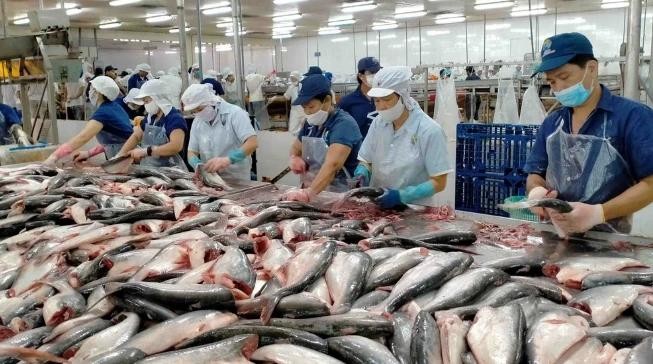Vietnamese businesses get more orders thanks to good export market shift
Vietnamese businesses have made good decision to shift their export markets; as a result, they have been getting more orders.

The quantity and value of export orders increased, and unit prices for several product groups hit new highs - these are good indicators of export turnover in the first nine months of 2024. This significant transformation can be attributed to businesses making substantial adjustments to their export markets.
Of the total export turnover in the first nine months of 2024, estimated at nearly US$300 billion , up 15.4 percent over the same period last year, the United States is Vietnam's largest export market. Next are China, Europe, ASEAN, South Korea, and the rest are other markets.
General Director of Tan Quang Minh Production and Trading Company Nguyen Dang Hien recalled the challenges faced by exporters at the beginning of the year. Just as businesses anticipated a surge in exports, the Suez Canal conflict, a major shipping route, disrupted many Vietnamese orders bound for Europe and the Middle East. The rising costs and extended delivery times put companies at risk of damaged goods before reaching their customers.Therefore, businesses have urgently planned for the market shift.
At the time, many Vietnamese businesses are expanding their market share in the massive Chinese and Indian markets, which combined have over two billion consumers. Agricultural and aquatic products have seen significant growth in exports to the two densely-populated nations.
Since the beginning of this year, fruit and vegetable exports have reached nearly US$5.7 billion, a 34 percent increase compared to the same period last year and surpassing the total exports for all of 2023. This marks a new record for the fruit and vegetable export industry. Notable increases include pepper (42.6 percent), coffee (34.8 percent), tea (33.percent), and fruits and vegetables (33.2 percent).
Director Lam Mong Thuy of Kokofi Company stated that Vietnamese businesses have been getting familiar with the stringent technical requirements imposed by markets like Europe, Japan, and the United States; hence, exporting products into the Chinese market has not caused big problem for Vietnamese enterprises. However, in the past, companies hesitated to venture into this market due to concerns about competing with local firms.
The company's experience indicates that for Vietnamese products to excel in the Chinese market and globally, it is essential not only to meet quality standards and adopt sustainable production practices but also to embody the unique characteristics and identity of Vietnam. The success of the company's tea products, which utilize Vietnamese herbs such as perilla, Vietnamese balm, and Sophora japonica, serves as a prime example.
Expanding market share in China and Asia has alleviated concerns about logistics chain disruptions, providing businesses with opportunities to tap into vast markets that share similar taste preferences and favorable trading conditions.
Along with that, Vietnamese enterprises have been still taking heed to traditional and new markets. Nguyen Dinh Tung, General Director of Vina T&T Company, stated that since the start of the year, the company has regularly exported Vietnamese fruits like grapefruit, dragon fruit, mango, and star apple to the US market. While shipping times have been extended at times, the products have been well-preserved proving the enormous potential of this market.
Meanwhile, General Director Nguyen Ngoc Luan of Global Trade Linkage Company disclosed that in addition to efforts to maintain traditional markets, the company also has adopted a strategy to tap new markets.
According to his revelation, at the start of this year, the company consistently secured a series of contracts to supply processed coffee products to the Middle East and Hala markets. Agricultural and processed food products derived from Vietnamese agriculture and aquaculture have gained significant advantages due to a notable rise in consumer preference over the past two years.
While Vietnamese products were previously recognized in these markets, they often appeared under foreign brands. In recent years, as part of a strategy to enhance market presence alongside the Vietnamese brand, these products have achieved stronger positions, leading to an increase in partner orders that have become more stable.
Furthermore, not only has the volume of orders risen, but domestic companies are also enthusiastic about the substantial increase in unit prices.
Previously, Vietnamese items were not new to customers in these nations, but they frequently appeared under borrowed brands.
In recent years, the strategy of expanding market share alongside the Vietnamese brand has led to improved standings for Vietnamese products. An increase in orders placed by partners that remained more stable has delighted domestic firms as the prices of products also hiked.
Nguyen Ngoc Hoa, Chairman of the Ho Chi Minh City Business Association, stated that, in the industrial raw materials market, Robusta coffee prices hit approximately US$5,500 a ton, while Arabica surpassed US$6,000 per ton, an all-time high.
Specifically, coffee contract prices for November delivery have surged by nearly 6 percent, reaching a new all-time high. Records indicate that Vietnam currently has 30 export items valued at over US$1 billion each, including 6 items exceeding $10 billion. To facilitate business growth and market expansion, Ho Chi Minh City is implementing an investment incentive program offering up to VND200 billion in capital support per project, with a 100 percent interest rate subsidy."








